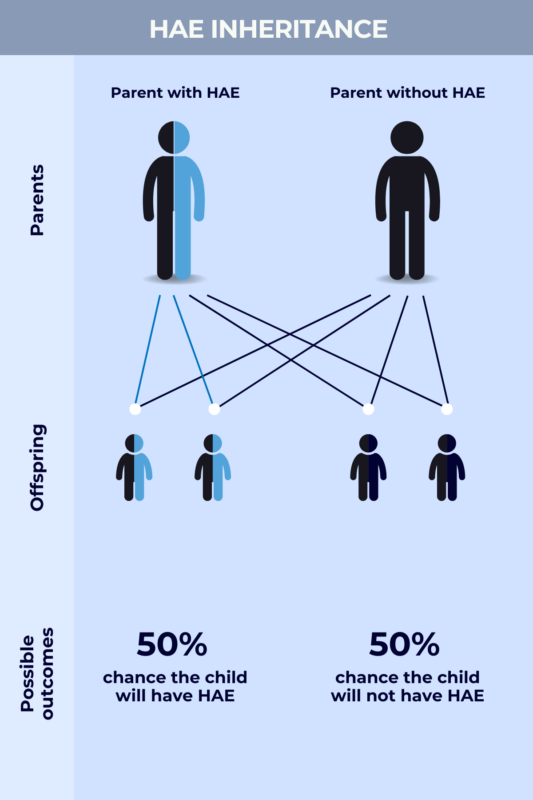
Family inheritance: Decoding the genetics of hereditary angioedema
Last updated May 20, 2024, by Lindsey Shapiro, PhD

Hereditary angioedema (HAE) is a genetic form of angioedema, which is characterized by sudden and recurrent swelling attacks in the deep layers of the skin. In HAE, such attacks are caused by mutations in various genes that lead to an overproduction of a molecule called bradykinin. This protein is involved in causing blood vessels to widen, allowing fluid to escape to nearby tissues and resulting in swelling.
These mutations are usually, but not always, passed down from an HAE-affected parent to their child. For this reason, HAE testing may involve a review of family history and genetic testing to confirm the presence of a disease-causing mutation.
How is HAE inherited?
HAE typically runs in families, with children inheriting the disease-causing mutation from their parents. A person has two copies of most genes — one from their biological mother and one from their father. While there are multiple HAE types involving different genes, the inheritance patterns are similar.
The disease is inherited in an autosomal dominant manner, which means that only one parent has to pass on to their child a disease-causing mutation for symptoms to appear. A parent with the condition has a 50% chance of passing it on to their child.
Still, HAE inheritance is not always as straightforward as a person with the disease passing it on to their children. While about three-quarters of HAE cases will develop this way, for the others with HAE, there is no family history of the disease. Instead, it happens when a spontaneous, or de novo, mutation arises in the genetic code. This might occur in the parent’s egg or sperm cells that eventually form the embryo, or in the baby’s own cells during embryonic development.

Genes associated with HAE
There are three main types of HAE with different genetic causes, but all generally lead to too much bradykinin being produced. The most common forms — HAE types 1 and 2 — are caused by SERPING1 gene mutations. The less common HAE type 3 is usually due to F12 gene mutations.
- SERPING1 carries instructions for making the C1-inhibitor protein (C1-INH) that normally help limit bradykinin production. In HAE type 1, mutations prevent C1-INH from being produced, leading to a C1 inhibitor deficiency that drives more bradykinin production. Various types of mutations occurring at different points in the SERPING1 genetic code can be observed.
- In HAE type 2, mutations occur mostly in a specific protein-coding region of SERPING1 called exon 8 and lead to the production of a dysfunctional C1-INH protein that can’t inhibit bradykinin production as effectively as it should.
- In HAE type 3, C1-INH activity is normal. Instead, this type of HAE is usually caused by mutations in the F12 gene, which provides instructions for making coagulation factor XII protein that is involved in bradykinin production. Disease-causing mutations drive the protein to be more active than usual, stimulating bradykinin production.
In rare instances, mutations in other genes have been linked to HAE with normal C1-INH activity. These genes include PLG, ANGPT1, KNG1, MYOF, and HS3ST6. While these mutations may be broadly grouped as HAE type 3, it has been proposed that each represents its own distinct disease subtype.
How HAE symptoms can vary
In general, HAE genetics don’t significantly affect disease presentation. All types of HAE involve symptoms of swelling attacks that most commonly affect the eyes, face, and extremities (hands and feet), though it can also involve other areas of the body.
The frequency, duration, and severity of HAE attacks varies significantly from person to person, even among those in the same family who have the same mutations. For example, while one person with a SERPING1 mutation might experience severe attacks multiple times per week, a relative with the same mutation might only have a single mild attack once a year.
It is not exactly known what underlies those differences, and a particular relationship between mutation types and clinical disease presentation has not been well established.
Compared with other types of nonhereditary angioedema, HAE symptoms may differ. For example, while a person with allergy-induced angioedema may experience itching and hives associated with their swelling attacks, this isn’t as common in HAE.
Testing for HAE
An HAE diagnosis is often suspected if a person is experiencing characteristic swelling attacks and/or has a family history of the disease. Findings from this review of family and symptom history will help a doctor know when and how to test for HAE.
People with suspected HAE will usually first have a blood test for HAE that looks at levels of C4, a protein related to C1-INH that is normally diminished in HAE types 1 and 2. Another HAE test may check C1-INH levels or activity.
But for people with rarer causes of HAE — where C1-INH and C4 levels are normal — there are no definitive lab tests to identify the disease. In these cases, genetic testing to look for disease-causing mutations in genes other than SERPING1 is the only way to get a definitive diagnosis. Genetic testing also might help confirm the diagnosis for HAE types 1 and 2.
If no genetic underpinnings are linked to the swelling attacks, there are other tests that can look for nonhereditary causes of angioedema.
After HAE is diagnosed, families may receive genetic counseling to help them understand the results and how HAE will affect them and their families. As HAE can be passed down from parents to children, this also can help people who are considering getting pregnant with family planning.
Angioedema News is strictly a news and information website about the disease. It does not provide medical advice, diagnosis or treatment. This content is not intended to be a substitute for professional medical advice, diagnosis, or treatment. Always seek the advice of your physician or other qualified health provider with any questions you may have regarding a medical condition. Never disregard professional medical advice or delay in seeking it because of something you have read on this website.
Recent Posts
- 1 lonvo-z dose keeps most HAE patients attack-free up to 3 years
- For many of us, becoming a patient advocate wasn’t optional
- FDA extends Orladeyo approval to children as young as 2
- With chronic illness, we can’t brush off holiday stress so easily
- Abrupt danazol stop in HAE can cause temporary hepatitis: Study



